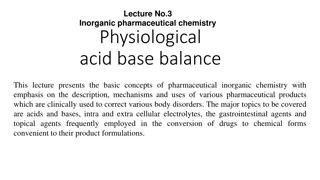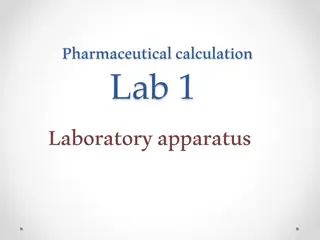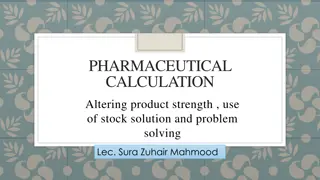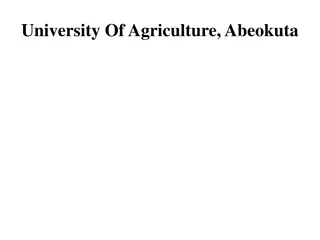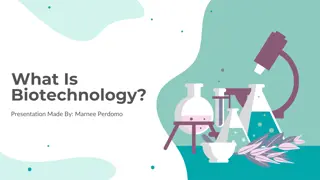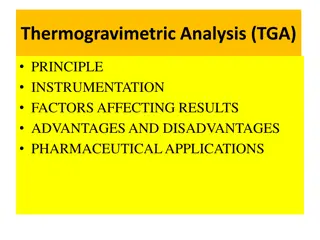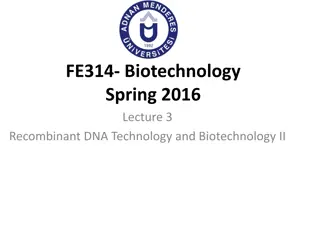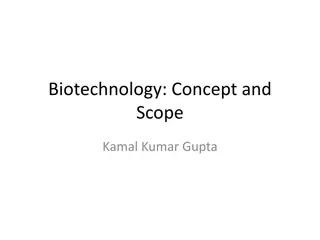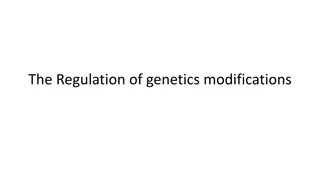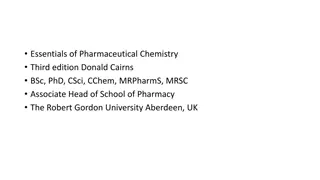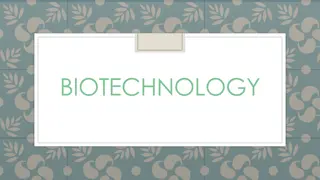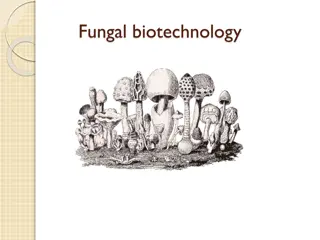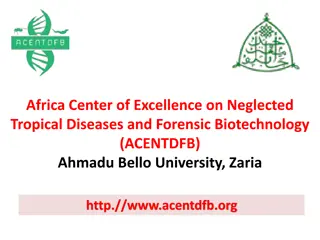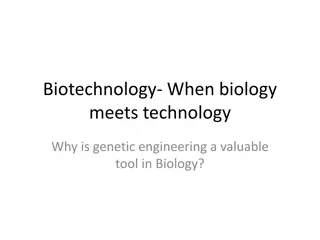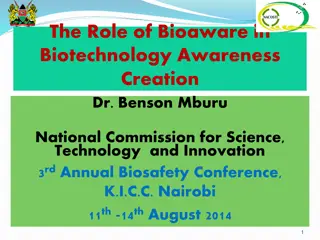Introduction to Biotechnology in Pharmaceutical Sciences: A Comprehensive Overview by Swarnakshi Upadhyay
Biotechnology in pharmaceutical sciences encompasses the application of scientific and engineering principles to utilize biological agents for various services. It includes molecular biology for production of pharmaceuticals like antibiotics, proteins, and enzymes, as well as large-scale production of bioactive compounds. The scope of biotechnology extends to areas such as biochemistry, microbiology, immunology, medical biotechnology, genetics, cloning, and genetic engineering. The field plays a crucial role in research, improving crop traits, developing disease-resistant crops, and enhancing nutritional quality. Biotechnology tools are utilized for early disease detection, genetic modification of organisms, and production of vaccines and antibiotics.
Download Presentation

Please find below an Image/Link to download the presentation.
The content on the website is provided AS IS for your information and personal use only. It may not be sold, licensed, or shared on other websites without obtaining consent from the author.If you encounter any issues during the download, it is possible that the publisher has removed the file from their server.
You are allowed to download the files provided on this website for personal or commercial use, subject to the condition that they are used lawfully. All files are the property of their respective owners.
The content on the website is provided AS IS for your information and personal use only. It may not be sold, licensed, or shared on other websites without obtaining consent from the author.
E N D
Presentation Transcript
Introduction to Biotechnology with reference to Pharmaceutical Sciences By Swarnakshi Upadhyay Assistant Professor School of Pharmaceutical Sciences
DEFINITION It is defined as the application of scientific and engineering principles to the processing of material by biological agents to provide good services. The British biotechnologists define biotechnology as The application of biological organisms, systems, or processes to the manufacturing and service industries .
SCOPE AND IMPORTANCE OF BIOTECHNOLOGY BIOTECHNOLOGY HAS TWO MAJOR AREAS: Molecular biology Large scale production of pharmaceuticals/ biochemical (antibiotics, proteins, enzymes). Molecular biology: It deals with understanding the genetics of plants, animals, human beings and micro- organisms. This has helped in determining the pathophysiology of various diseases and also simplified their early detection. So it has led to development of diagnostic tools which are useful in disease identification. Early detection is dependent on presence of biomarkers e.g. proteins, enzyme, DNA, etc which is present in an organism only in diseased state, with the help of biotechnology tools we are able to identify them, and hence it helps in early detection of disease. Molecular biology tools are also used for improvement in the genetic makeup of micro- organism e.g. Production of human insulin using micro-organism by inserting the gene coding for insulin. Modification in plant genetic make-up can be done using biotechnology tools to obtain biopharmaceutical products/ phytochemicals that are used in treatment of many diseases. Pre- implantation genetic diagnosis (PGD): It is a method used to determine the presence of genetic disorders into the embryo which is obtained by in-vitro fertilization. And the diagnosis is done before the embryo is implanted hence the term pre- implantation.
Large scale production of pharmaceuticals/ biochemical (antibiotics, proteins, enzymes). Micro-organisms are modified in such a way that they will produce large quantities of particular antibiotics e.g. Modified strains of Penicillim notatum produces higher yield of penicillin as compared to natural species. Large scale production of antibiotics through fermentation of micro-organisms, in which the desired gene is inserted. Use of enzymes and cells for synthesizing various chemicals. Eg. Biochemical enzymes carry out the reaction very efficiently compared to natural process and are eco-friendly. Biological enzymes required in some reactions can be produced by modifying it. Several vaccines are prepared using biotechnology techniques. Eg. Monoclonal antibodies, recombinant vaccines, three in one vaccine, etc.
Scope The areas in biotechnology also include Biochemistry, Microbiology, Immunology Medical biotechnology, Genetics, Cloning, Genetic Engineering, r-DNA Technology, etc. The scope of Biotechnology is majorly in research. Biotechnology of plants and specific crops Genetic engineering is used for improving the yield and quality traits i.e. disease resistant crops like Bt (Bacillus thuringiensis) cotton. To fulfill some nutritional requirements of human beings e.g. Golden rice- gene coding for vitamin A is inserted into the genome of rice plant, which then produces rice rich in vitamin A and the nutritional requirement is also fulfilled. Metabolite production for several antibiotics. Since there are many drugs who themselves are not active but the activity is expressed by their metabolites. Rapid clonal propagation for conserving the plant species. Improvements in plant breed to produce phytochemicals which are used in treatment of various diseases. Through modifying the plant genome, the quality and quantity of food and nutrients produced can be raised. Eg. Pomato in this plant potato grows under the ground and tomato on the surface in the same plant. Raising demand of food due to rising population and less area for farming problems can be solved by production of such biotechnology improved products. Production of edible vaccines- Introduction of the vaccine into banana or by infecting any plant by a bacterium carrying a gene of pathogen which when consumed will trigger the immune system. This favors palatability and convenience for consumer to take the vaccine without syringe.
Animal biotechnology There are certain biotechnology experiments in which animals are cloned for various reasons. To study the basic biology of cells, i.e. how the cells are formed, cells tissues organs organ system organism. Animal cloning is done for herd/ breed improvement. Animal cloning has helped in preserving the endangered species. Eg. Clone of Siberian ibex. Genetic manipulation for improving fertility and reproduction. Eg. Dolly sheep. Breed improvement, for getting horses with high running speed. By inserting gene coding for milk production from higher milk yielding breed in low milk producing breed will result in high yield of milk production. Quality, egg production, disease control in chickens. Pharming- It is the production of pharmaceuticals in animals engineered to contain a foreign drug-producing gene. Eg. The Goats, genetically modified contains human gene for clot- dissolving protein that is produced in the milk which is not found in the milk of normal goat.
Marine biotechnology It deals with the use and improvement of fish, macro- and micro- algae for food production, environmental uses and various commercial applications. E.g. Salmon fish, size and weight is increased by making some genetic changes which would enhance its commercial value. Embryonic stem cells Stem cells are the body cells which are collected from the embryonic fluid and stored in appropriate conditions. It has the ability to transform itself in any form of body cell in presence of a suitable nutrient medium and hence can be used in future by the person to whom the stem cells belong in case of any drastic injury. Forensic science DNA fingerprinting is used in resolving paternity issues. DNA acts as individuals identity and biomarker. Also to find out the criminal from the suspects.
RELEVANCE TO THE PHARMACEUTICAL INDUSTRY Biotechnology is the science which combines biology with technology that is being used widely in pharmaceutical sector. This science has proved to be a boon especially in manufacturing of vaccinations and genetic testing Production of therapeutic proteins and hormones using genetically modified organisms/ cloning animals. Fermentation products like antibiotics, vaccines or drugs. Gene correction, for treatment of genetic disorders. Drug delivery to specific tissues. Production control using biosensors. Standardization of chemotherapeutic agents and the diagnostic aids using the gene cloning technology. r-DNA technology. Enzyme immobilization for production of pharmaceuticals. Monoclonal antibodies, used in production of vaccines and also in diagnosis of certain diseases through antibody- antigen interaction.
HISTORY OF BIOTECHNOLOGY The history of biotechnology begins with zymotechnology, which commenced with a focus on brewing techniques for beer. By World War I, however, zymotechnology expanded to tackle larger industrial issues, and the potential of industrial fermentation gave rise to biotechnology. These debates gained exposure in 1975 at the Asilomar Conference, where Joshua Lederberg was the most outspoken supporter for this emerging field in biotechnology. By as early as 1978, with the synthesis of synthetic human insulin, Lederberg s claims proved to be valid, and the biotechnology industry grew rapidly. Each new scientific advance became a media event designed to capture public support, and by the 1980s, biotechnology grew into a promising real industry. In 1988, only five proteins from genetically engineered cells had been approved as drugs by the United States Food and Drug Administration (FDA), but this number would skyrocket to over 125 by the end of the 1990s. The field of genetic engineering remains a heated topic of discussion in today s society with the advent of gene therapy, stem cell research, cloning, and genetically modified food. While it seems only natural nowadays to link pharmaceutical drugs as solutions to health and societal problems, this relationship of biotechnology serving social needs began centuries ago.



